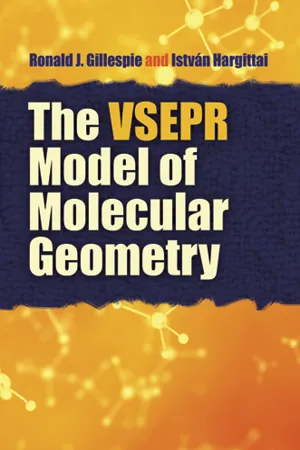Chemistry
VSEPR
VSEPR (Valence Shell Electron Pair Repulsion) theory is a model used in chemistry to predict the geometry of individual molecules based on the number of electron pairs in the molecule's valence shell. It states that electron pairs repel each other, leading to a specific arrangement of atoms around a central atom. This theory helps in understanding molecular shapes and bond angles.
Written by Perlego with AI-assistance
Related key terms
Related key terms
1 of 4
Related key terms
1 of 3
6 Key excerpts on "VSEPR"
- eBook - ePub
Inorganic Chemistry
Some New Facets
- Ram Charitra Maurya(Author)
- 2021(Publication Date)
- De Gruyter(Publisher)
Chapter I Valence shell electron pair repulsion (VSEPR) theory: principles and applications1.1 Introduction
This theory was first formulated by Sidgwick and Powell (1940) based on the repulsions between electron pairs, known as valence shell electron pair repulsion (VSEPR) theory to explain molecular shapes and bond angles of molecules of non-transition elements. Later on Gillespie and Nyholm (1957) developed an extensive rationale (basis/underlying principle) called VSEPR model of molecular geometry.According to this theory, the shape of a given species (molecule or ion) depends on the number and nature of electron pairs surrounding the central atom of the species.1.2 Postulates of VSEPR theory: Sidgwick and Powell
The various postulates of this theory are as follows:- The unpaired electrons in the valence shell of central atom form bond pairs (bps) with surrounding atoms while paired electrons remain as lone pairs (lps).
- The electron pairs surrounding the central atom repel each other. Consequently, they stay as far apart as possible in space to attain stability.
- The geometry and shape of the molecule depend upon the number of electron pairs (bond pair as well as lone pair) around the central atom.
-
The geometrical arrangements of electron pairs with different number of electron pairs around central atom are given in Table 1.1 .
Table 1.1: Shapes of the various molecules depending upon the number of shared electrons around the central metal atom.1.3 Rules proposed by Gillespie and Nyholm
The following rules have been proposed by Ronald Gillespie and Ronald Sydney Nyholm of University College of London to explain the shape of a number of polyatomic molecules or ions.1.3.1
- eBook - ePub
- Tony Cox(Author)
- 2004(Publication Date)
- Taylor & Francis(Publisher)
In spite of a lack of firm theoretical foundation the VSEPR model is widely applicable to molecular geometries and even to some solids. Occasionally it fails to predict the correct structure.VSEPR principlesRelated topicsElectron pair bonds (C1 )Molecular symmetry and point groups (C3 )Molecular orbitals: polyatomics (C6 )Stereochemical arrangement becomes an issue whenever an atom is bonded to principles two or more others. Thus triatomic species AB2 can be linear (e.g. CO2 , ) or bent (e.g H2 O 1, ). It is observed that when a central atom has no nonbonding electrons, the surrounding atoms are usually arranged in a regular way that spaces them as far apart as possible. When nonbonding electron pairs are present in the valence structure, however, less regular arrangements of bonds are often found. The valence shell electron pair repulsion (VSEPR) model is based on the idea that both bonding and nonbonding electron pairs in the valence shell of an atom ‘repel’ each other. This idea is useful but can be misleading if taken too literally. Detailed calculations show that the shape of a molecule is determined by a combination of factors, of which the electrostatic repulsion between electrons is not the most important. Furthermore, the real electron distribution in a molecule is much more evenly spread out than the localized pictures used in VSEPR (1, 2, …) suggest. It is best to think of ‘repulsion’ as coming primarily from the exclusion principle (see Topic A3 ), which forces electron pairs to occupy orbitals in different regions of space.The basic principles of the model are as follows.(i) Valence electron pairs round an atom (whether bonding or nonbonding) adopt a geometry that maximizes the distance between them. The basic geometries usually observed with 2–7 pairs are shown in Fig. 1 - eBook - ePub
- Ronald J Gillespie, Istvan Hargittai(Authors)
- 2013(Publication Date)
- Dover Publications(Publisher)
Although it is only a rough approximation to assume that electron-pair domains are nonoverlapping, we will see in Chapter 7 that the overlapping of electron-pair domains in a valence shell is minimized in the most stable arrangement in which the electron pairs are as far apart as possible. In any other arrangement, there is more overlapping of the electron-pair domains and the energy of the system is increased. Thus electron pairs behave as if they repel each other and this is the reason for the name VSEPR (valence-shell electron-pair repulsion) model. We will see that in discussing molecular geometry it will generally be more convenient to emphasize the space-occupying properties of electron pairs rather than their mutual repulsion. Moreover, the original emphasis on electron-pair repulsion led to the erroneous idea, sometimes found in discussions of the VSEPR model, that it is a classical electrostatic model and therefore not in accord with the quantum mechanical description of a molecule. The discussion in this book is therefore based mainly on the effect of the different sizes and shapes of electron-pair domains on molecular geometry. An alternative name for the model would be the VSEPD (valence-shell electron-pair domain) model, but we will continue to use the name VSEPR because it is now so well established.The “spheres and elastic bands” model described above gives the arrangement of a given number of equal spheres in which they are packed as closely as possible around a central point. An alternative way to obtain these same arrangements is to consider the packing of a given number of equal circles, or circular domes, on the surface of a sphere so that they occupy as much as possible of the surface of the sphere. The central points of each circular dome then have the same arrangement as obtained by the points-on-a-sphere model (Figure 3.8 ).Figure 3.8 The octahedral arrangement of six equal circles on a sphere maximizes the area covered by the circles.DEVIATIONS FROM IDEAL BOND ANGLES
We have seen that we can predict the general shapes of molecules from the total number of electron pairs in the valence shell of the central atom. However, the bond angles in many molecules are not exactly equal to the ideal angles corresponding to these shapes. Qualitative predictions of these deviations from the ideal bond angles can be made by taking into account the differences in the sizes and shapes of the electron-pair domains in a valence shell. The electron-pair domains in a valence shell are not all equivalent for three important reasons: - Mark Kernion, Joseph A. Mascetta(Authors)
- 2022(Publication Date)
- Barrons Educational Services(Publisher)
hybridization theory. (VSEPR represents Valence Shell Electron Pair Repulsion.)VSEPR—Electrostatic Repulsion
VSEPR uses as its basis the fact that like charges will orient themselves in such a way as to diminish the electrostatic repulsion between them.EXAMPLE: BeF2 , beryllium fluoride1.Mutual repulsion of two electron clouds forces them to the opposite sides of a sphere. This is called a linear arrangement.EXAMPLE: BF3 , boron trifluoride2.Minimum repulsion between three electron pairs occurs when the pairs are at the vertices of an equilateral triangle inscribed in a sphere. This is called a trigonal-planar arrangement.EXAMPLE: CH4 , methane3.Four electron pairs are farthest apart at the vertices of a tetrahedron inscribed in a sphere. This is called a tetrahedral arrangement or a tetrahedral-shaped distribution of electron pairs.EXAMPLE: SF6 , sulfur hexafluoride4.Mutual repulsion of six identical electron clouds directs them to the corners of an inscribed regular octahedron. This is called an octahedral arrangement.TIPThese basic arrangements are important to learn!VSEPR and Unshared Electron Pairs
Ammonia (NH3 ) and water (H2- eBook - ePub
- Gavin Whittaker, Andy Mount, Matthew Heal(Authors)
- 2000(Publication Date)
- Taylor & Francis(Publisher)
H1 ELEMENTARY VALENCE THEORYKey Notes
Valence theories Valence theories attempt to describe the number, nature, strength and geometric arrangements of chemical bonds between atoms. Although they have been superseded by more sophisticated theories, Lewis theory and VSEPR theory provide two complementary approaches to bonding which remain useful for elementary descriptions of simply bonded molecules. Lewis theory Lewis theory is a primitive form of valence bond theory, with atoms forming bonds by sharing electrons. No attempt is made to describe the three-dimensional geometric shape of the molecule. The main group elements tend to adopt inert gas electron configurations (octets), although some elements, such as boron or beryllium are energetically stable with incomplete octets. Many larger elements display hypervalency, where it is energetically favorable for more than eight valence electrons to be held in an expanded octet. VSEPR theory Valence shell electron pair repulsion (VSEPR) theory explains the shapes of molecules by focusing on the bonding orbitals around each atom in isolation. VSEPR dictates that the geometry which maximizes the distances between the electron pairs in the orbitals is adopted. The basic geometry from the minimization of electron-electron repulsion is modified by the differing repulsion strengths of bonding and non-bonding pairs. In ammonia, NH3 , for example, there are four valence shell pairs, giving an underlying tetrahedral geometry, but the greater repulsive effect of the non-bonding pair forces the bonding pairs closer to one another than in the ideal tetrahedral geometry. Related topics Many electron atoms (G6 ) Molecular orbital theory of diatomic molecules I (H3 ) Valence bond theory (H2 ) Valence theories
Valence theories - eBook - ePub
Organic Chemistry
An Acid-Base Approach
- Michael B. Smith(Author)
- 2022(Publication Date)
- CRC Press(Publisher)
Figure 3.6 are available, a practical alternative is the model kit usually suggested for an organic chemistry course. Using such kits will give useful information not only for the shape of molecules but for many concepts. This option is strongly recommended. In lieu of computer software or a model kit, a method is used for drawing structures that assumes a tetrahedral shape around a central atom to predict the three-dimensional shape of molecules.VSEPR ModelThe discussion in Section 3.5.1 showed that carbon has a valence of four and forms covalent bonds to four atoms or groups of atoms. Nitrogen is in group 15 has a valence of three and forms molecules with three covalent bonds. Oxygen is in group 16, has a valence of two and forms molecules with two covalent bonds. Based on this knowledge of real molecules, the Valence Shell Electron Pair Repulsion or VSEPR model predicts the shape of molecules. The shape of a given molecule is determined by assuming a tetrahedral array of the atoms attached to a central C, N, or O, including unshared electron pairs. Since electrons exert an influence on the shape of a molecule, they must be included in the tetrahedral array. In all cases, the molecules formed will be neutral: they have no charges. The VSEPR model is most useful for molecules made from second row elements, but it is sometimes used for some molecules that have atoms in other rows of the periodic table.The molecules chosen to illustrate the VSEPR model are methane, ammonia, and water, as shown in Figure 3.10 . These three molecules are drawn first in the Lewis electron dot representations and then again using the wedge-dashed line notation based on the VSEPR model using a tetrahedral array of the attached atoms. The tetrahedral structure of methane is repeated from Section 3.5.1. Ammonia (H3 N) has a tetrahedral array around nitrogen if the electron pair is taken into account. Since the electron pair cannot be seen, the focus is only on the atoms and ammonia has the pyramidal shape shown. Water (HOH) has two electron pairs that occupy the corners of a tetrahedral shape, as shown, but if the focus is only the atoms, water is a bent ( angular ) molecule. Ball-and-stick molecular models of each molecule are shown, which confirm the shape predicted by the VSEPR model. This model does a poor job of accurately predicting bond lengths and angles since it underestimates the importance of electron pairs. It also does not take the size
Index pages curate the most relevant extracts from our library of academic textbooks. They’ve been created using an in-house natural language model (NLM), each adding context and meaning to key research topics.
Explore more topic indexes
Explore more topic indexes
1 of 6
Explore more topic indexes
1 of 4





